Stock market boom and bear market. How do you know when they start?
A very large number of phenomena in the world around us are repetitive and cyclical. I mean, for example, the time of the day, the season, or the cycle of the pendulum clock. In addition to being repetitive, they occur fairly regularly.
The bull market and bear market are among the stock market cycles. During the first (numerous increases with small, downward corrections) we are talking about the bull market, and during the second (strong decreases with slight upward rebounds) we are talking about the bear market. The current markets look completely different than those of 30 years ago. However, it is worth considering how knowledge on this subject can help us in investing?
The game is short
It's known that talking about the concept of a bull or bear market is very broad depending on the prevailing business cycle. If the market is dominated by aversion to risky assets and we are in the recession phase, it is known that capital will "run away" from stocks to safer bonds or commodities (mainly gold). At that time, we can also talk about a bull market, but for debt securities and precious metals markets. Therefore, this concept must be considered in accordance with the prevailing economic cycle.
Simply simplifying, we speak of a bull or bear market when there are long-lasting declines or rises in a specific market. The bear market is usually shorter than the boom.
READ ALSO: The Kondratieff cycle - what awaits us in the coming years?
What is the use of knowing these two concepts? First of all, to choose a specific strategy for the prevailing stock market conditions. It is easier for us to judge the "good moment" to buy companies and the time when it is worth keeping the stocks without getting rid of them at low prices. Therefore, we should know some very general and statistical rules about the bull market and bear market.
The sector is unequal to the sector
It is worth adding that bearish and boom occur at different times in different sectors. A market collapse does not happen at the same time in every area of the economy. After observing the crises we have already gone through, as well as the general market dependencies, a simple conclusion can be drawn (which, of course, does not always have to work in the future). Usually, after a period of declines, the "first" boom is visible on the currency market, on the dollar.
Then we can observe increases in bonds, the stock market, real estate and finally commodities. The individual phases may overlap, but the correct order is nevertheless kept.
Model of the several-year Kitchin cycle
One of the people who wanted to present the bullish and bearish phases in individual markets was Joseph Kitchin. His the model of cycles on the stock exchange is based on several years of short market changes (about 4 years). It is associated with changes in inventories, wholesale prices, as well as the settlement of interbank operations that take place at that time.
It distinguishes between the following phases:
- Phase I: The Recession Begins - bull market in the bond market, bear market in companies and natural resources
- Phase II: Deepening Recession - gradual end of the bull market in the bond market, the end of the bear market in the stock market, declines in commodity prices
- Phase III: The Beginning of the Recovery - slight bond yields (declining), stocks begin to rise, commodity prices are stable
- Phase IV: Expansion in progress - bear market in bonds, bull market in equities (strong increases), commodity prices are rising
- Phase V: The Peak of Growth - bonds in downward trend, stocks are peaking and the first declines begin, a strong bull market on the commodity market
- Phase VI: The Recession Begins - the end of the bear market, the beginning of a strong decline in the equity market, the end of the commodity boom.
How long does the bull market and bear market last?
When talking about the duration of both cycles, they should first of all be considered in the context of a specific market. Considering our Stock Exchange, the bull market is on average 3 times longer than the bear market. The longest one occurred between 2001 and 2007. Markets grew on average by about 180% and fell by less than 50%.
In theory, a bear market is considered to be at least 20% of the stock market slump. It is worth adding that the average duration of the bull market (approx. 30 months) and bear market (approx. 10 months) corresponds to the theory and the Kitchin model presented above. It assumes a cycle based on 40 months.
One could find more links between the bull and bear market and, for example, the number of IPOs in a given year, or comparing emerging and developed markets in order to be able to spot leading signals for each of them earlier. Nevertheless, it must be borne in mind that each economy has a specific structure. Historical data may not always constitute a reliable basis for reference.
A certain amount of caution should be exercised here and, for example, the indices should be analyzed, bearing in mind their current structure and the market "environment" in which they operate.






















![Forex Club – Tax 9 – Settle tax on a foreign broker [Download the Application] Forex Club - Tax 9](https://forexclub.pl/wp-content/uploads/2024/02/Forex-Club-Podatek-9-184x120.jpg?v=1709046278)
![Trading View platform – solutions tailored to the needs of traders [Review] trading view review](https://forexclub.pl/wp-content/uploads/2024/03/trading-view-recenzja-184x120.jpg?v=1709558918)
![How to connect your FP Markets account to the Trading View platform [Guide] fp markets trading view](https://forexclub.pl/wp-content/uploads/2024/02/fp-markets-trading-view-184x120.jpg?v=1708677291)
![How to invest in ChatGPT and AI? Stocks and ETFs [Guide] how to invest in chatgpt and artificial intelligence](https://forexclub.pl/wp-content/uploads/2023/02/jak-inwestowac-w-chatgpt-i-sztuczna-inteligencje-184x120.jpg?v=1676364263)





![Izabela Górecka – “Success on the market depends not only on knowledge, but also on emotional stability” [Interview] Izabela Górecka - interview](https://forexclub.pl/wp-content/uploads/2024/04/Izabela-Gorecka-wywiad-184x120.jpg?v=1713870578)
![WeWork – the anatomy of the collapse of a company valued at $47 billion [WeWork, part II] wework bankruptcy story](https://forexclub.pl/wp-content/uploads/2024/04/wework-bankructwo-historia-184x120.jpg?v=1711729561)
![Adam Neumann – the man who screwed up Softbank [WeWork, part AND] adam neumann wework](https://forexclub.pl/wp-content/uploads/2024/04/adam-neumann-wework-184x120.jpg?v=1711728724)



![The most common mistakes of a beginner trader - Mr Yogi [VIDEO] Scalping - The most common mistakes of a beginner trader - VIDEO](https://forexclub.pl/wp-content/uploads/2024/03/Scalping-Najczestsze-bledy-poczatkujacego-tradera-VIDEO-184x120.jpg?v=1711601376)
![Learning patience: No position is also a position - Mr Yogi [VIDEO] Scalping - Learning patience - No position is also a position - VIDEO](https://forexclub.pl/wp-content/uploads/2024/03/Scalping-Nauka-cierpliwosci-Brak-pozycji-to-tez-pozycja-VIDEO-184x120.jpg?v=1710999249)
![When to exit a position and how to minimize losses - Mr Yogi [VIDEO] Scalping - When to exit a position and how to minimize losses - VIDEO](https://forexclub.pl/wp-content/uploads/2024/03/Scalping-Kiedy-wyjsc-z-pozycji-i-jak-minimalizowac-straty-VIDEO-184x120.jpg?v=1710336731)



















Leave a Response